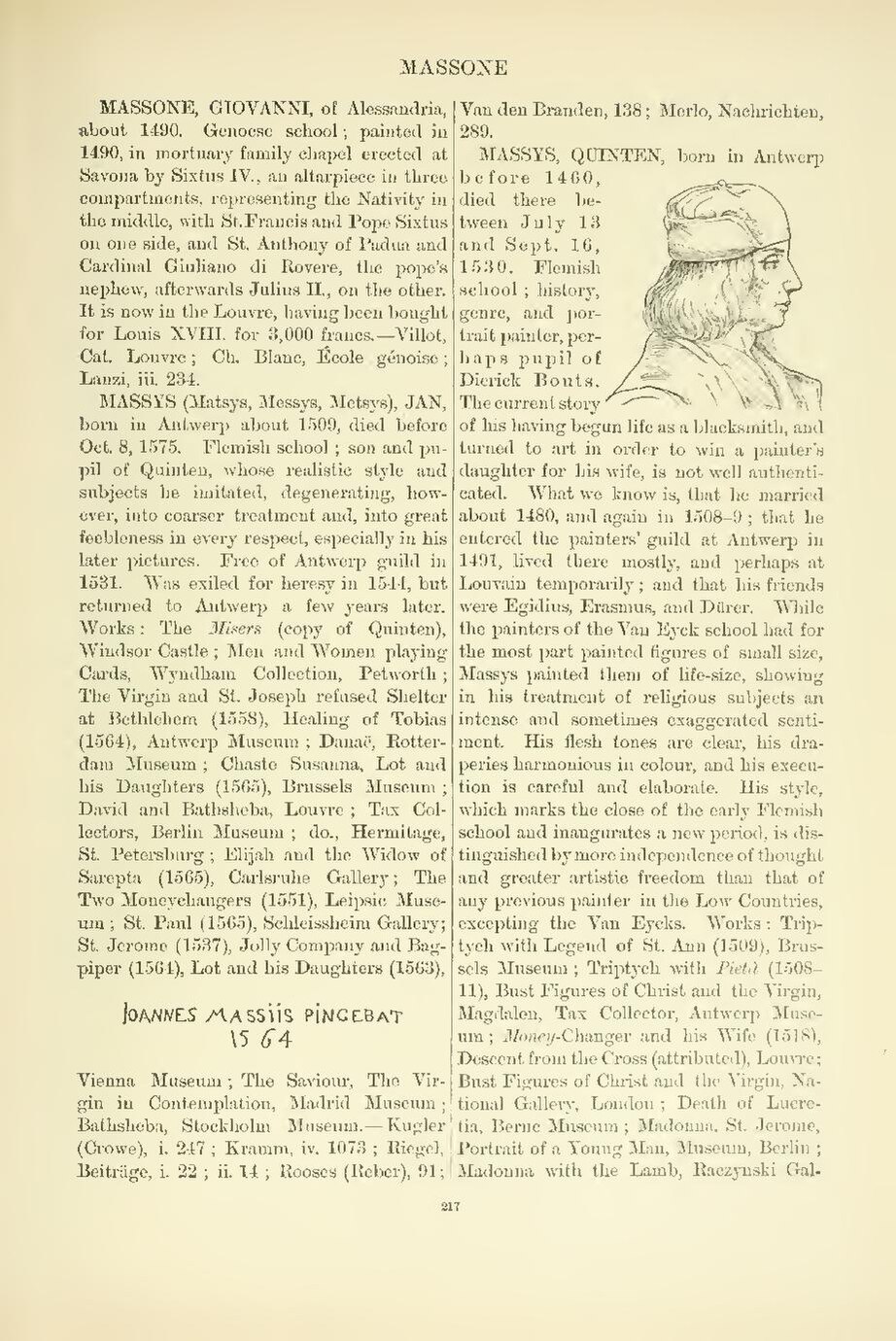MASSONE, GIOVANNI, of Alessandria, about 1490. Genoese school; painted in 1490, in mortuary family chapel erected at Savona by Sixtus IV., an altarpiece in three compartments, representing the Nativity in the middle, with St. Francis and Pope Sixtus on one side, and St. Anthony of Padua and Cardinal Giuliano di Rovere, the pope's nephew, afterwards Julius II., on the other. It is now in the Louvre, having been bought for Louis XVIII. for 3,000 francs.—Villot, Cat. Louvre; Ch. Blanc, École génoise; Lanzi, iii. 234.
An image should appear at this position in the text. To use the entire page scan as a placeholder, edit this page and replace "{{missing image}}" with "{{raw image|Cyclopedia of painters and paintings (IA cyclopediaofpain03cham).pdf/239}}". Otherwise, if you are able to provide the image then please do so. For guidance, see Wikisource:Image guidelines and Help:Adding images. |
MASSYS (Matsys, Messys, Metsys), JAN,
born in Antwerp about 1509, died before
Oct. 8, 1575. Flemish school; son and pupil
of Quinten, whose realistic style and
subjects he imitated, degenerating, however,
into coarser treatment and, into great
feebleness in every respect, especially in his
later pictures. Free of Antwerp guild in
1531. Was exiled for heresy in 1544, but
returned to Antwerp a few years later.
Works: The Misers (copy of Quinten),
Windsor Castle; Men and Women playing
Cards, Wyndham Collection, Petworth;
The Virgin and St. Joseph refused Shelter
at Bethlehem (1558), Healing of Tobias
(1564), Antwerp Museum; Danaë, Rotterdam
Museum; Chaste Susanna, Lot and
his Daughters (1565), Brussels Museum;
David and Bathsheba, Louvre; Tax Collectors,
Berlin Museum; do., Hermitage,
St. Petersburg; Elijah and the Widow of
Sarepta (1565), Carlsruhe Gallery; The
Two Moneychangers (1551), Leipsic Museum;
St. Paul (1565), Sclileissheim Gallery;
St. Jerome (1537), Jolly Company and Bag-*piper
(1564), Lot and his Daughters (1563),
Vienna Museum; The Saviour, The Virgin
in Contemplation, Madrid Museum;
Bathsheba, Stockholm Museum.—Kugler
(Crowe), i. 247; Kramm, iv. 1073; Riegel,
Beiträge, i. 22; ii. 14; Rooses (Reber), 91;
Van den Branden, 188; Merlo, Nachrichten,
289.
An image should appear at this position in the text. To use the entire page scan as a placeholder, edit this page and replace "{{missing image}}" with "{{raw image|Cyclopedia of painters and paintings (IA cyclopediaofpain03cham).pdf/239}}". Otherwise, if you are able to provide the image then please do so. For guidance, see Wikisource:Image guidelines and Help:Adding images. |
MASSYS, QUINTEN, born in Antwerp
before 1460,
died there between
July 13
and Sept. 16,
1530. Flemish
school; history,
genre, and portrait
painter, perhaps
pupil of
Dierick Bouts.
The current story
of his having begun life as a blacksmith, and
turned to art in order to win a painter's
daughter for his wife, is not well authenticated.
What we know is, that he married
about 1480, and again in 1508-9; that he
entered the painters' guild at Antwerp in
1491, lived there mostly, and perhaps at
Louvain temporarily; and that his friends
were Egidius, Erasmus, and Dürer. While
the painters of the Van Eyck school had for
the most part painted figures of small size,
Massys painted them of life-size, showing
in his treatment of religious subjects an
intense and sometimes exaggerated sentiment.
His flesh tones are clear, his draperies
harmonious in colour, and his execution
is careful and elaborate. His style,
which marks the close of the early Flemish
school and inaugurates a new period, is distinguished
by more independence of thought
and greater artistic freedom than that of
any previous painter in the Low Countries,
excepting the Van Eycks. Works: Triptych
with Legend of St. Ann (1509), Brussels
Museum; Triptych with Pietà (1508-11),
Bust Figures of Christ and the Virgin,
Magdalen, Tax Collector, Antwerp Museum;
Money-Changer and his Wife (1518),
Descent from the Cross (attributed), Louvre;
Bust Figures of Christ and the Virgin, National
Gallery, London; Death of Lucretia,
Berne Museum; Madonna, St. Jerome,
Portrait of a Young Man, Museum, Berlin;
Madonna with the Lamb, Raczynski Gal-
